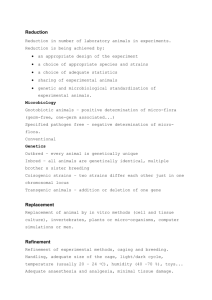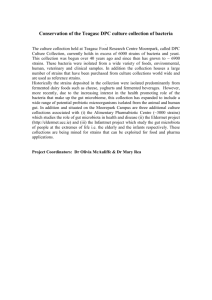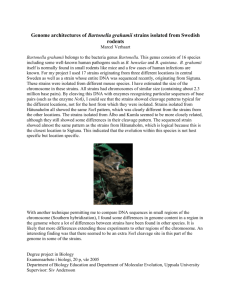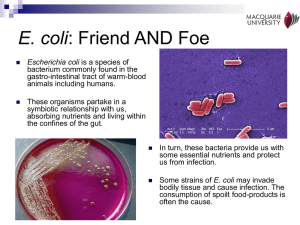Escherichia coli fimB Gene Expression Joshua Luedtke
advertisement
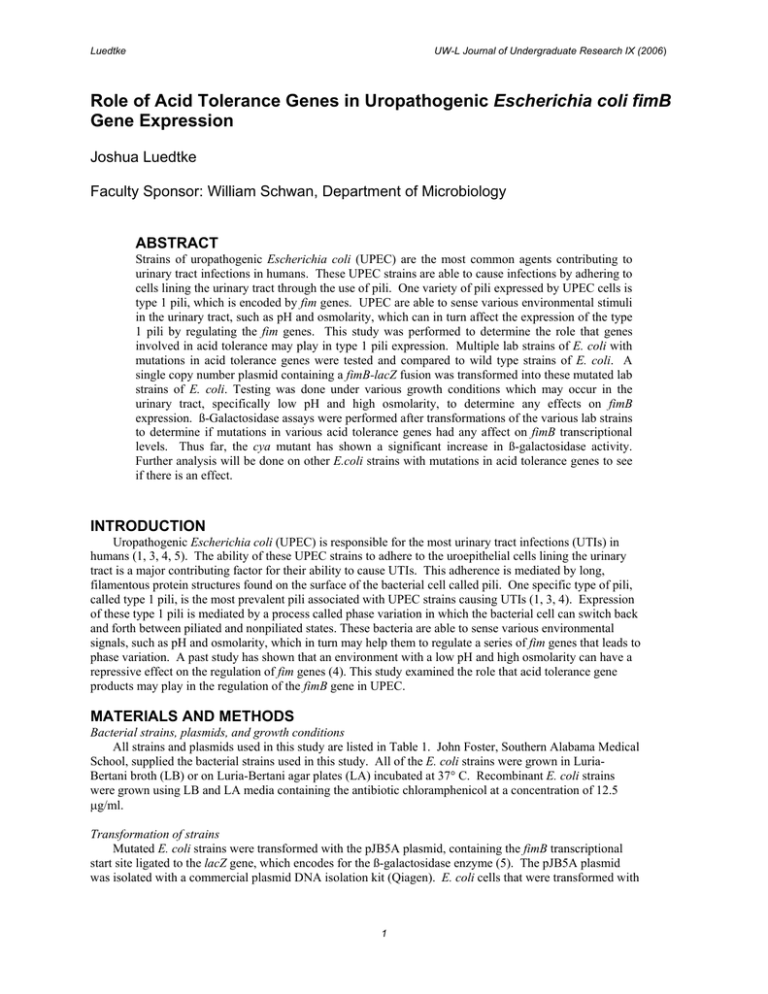
Luedtke UW-L Journal of Undergraduate Research IX (2006) Role of Acid Tolerance Genes in Uropathogenic Escherichia coli fimB Gene Expression Joshua Luedtke Faculty Sponsor: William Schwan, Department of Microbiology ABSTRACT Strains of uropathogenic Escherichia coli (UPEC) are the most common agents contributing to urinary tract infections in humans. These UPEC strains are able to cause infections by adhering to cells lining the urinary tract through the use of pili. One variety of pili expressed by UPEC cells is type 1 pili, which is encoded by fim genes. UPEC are able to sense various environmental stimuli in the urinary tract, such as pH and osmolarity, which can in turn affect the expression of the type 1 pili by regulating the fim genes. This study was performed to determine the role that genes involved in acid tolerance may play in type 1 pili expression. Multiple lab strains of E. coli with mutations in acid tolerance genes were tested and compared to wild type strains of E. coli. A single copy number plasmid containing a fimB-lacZ fusion was transformed into these mutated lab strains of E. coli. Testing was done under various growth conditions which may occur in the urinary tract, specifically low pH and high osmolarity, to determine any effects on fimB expression. ß-Galactosidase assays were performed after transformations of the various lab strains to determine if mutations in various acid tolerance genes had any affect on fimB transcriptional levels. Thus far, the cya mutant has shown a significant increase in ß-galactosidase activity. Further analysis will be done on other E.coli strains with mutations in acid tolerance genes to see if there is an effect. INTRODUCTION Uropathogenic Escherichia coli (UPEC) is responsible for the most urinary tract infections (UTIs) in humans (1, 3, 4, 5). The ability of these UPEC strains to adhere to the uroepithelial cells lining the urinary tract is a major contributing factor for their ability to cause UTIs. This adherence is mediated by long, filamentous protein structures found on the surface of the bacterial cell called pili. One specific type of pili, called type 1 pili, is the most prevalent pili associated with UPEC strains causing UTIs (1, 3, 4). Expression of these type 1 pili is mediated by a process called phase variation in which the bacterial cell can switch back and forth between piliated and nonpiliated states. These bacteria are able to sense various environmental signals, such as pH and osmolarity, which in turn may help them to regulate a series of fim genes that leads to phase variation. A past study has shown that an environment with a low pH and high osmolarity can have a repressive effect on the regulation of fim genes (4). This study examined the role that acid tolerance gene products may play in the regulation of the fimB gene in UPEC. MATERIALS AND METHODS Bacterial strains, plasmids, and growth conditions All strains and plasmids used in this study are listed in Table 1. John Foster, Southern Alabama Medical School, supplied the bacterial strains used in this study. All of the E. coli strains were grown in LuriaBertani broth (LB) or on Luria-Bertani agar plates (LA) incubated at 37° C. Recombinant E. coli strains were grown using LB and LA media containing the antibiotic chloramphenicol at a concentration of 12.5 μg/ml. Transformation of strains Mutated E. coli strains were transformed with the pJB5A plasmid, containing the fimB transcriptional start site ligated to the lacZ gene, which encodes for the ß-galactosidase enzyme (5). The pJB5A plasmid was isolated with a commercial plasmid DNA isolation kit (Qiagen). E. coli cells that were transformed with 1 Luedtke UW-L Journal of Undergraduate Research IX (2006) the plasmid were selected for on LA containing the antibiotic chloramphenicol, and screened for the enzyme ß-galactosidase using a compound called X-Gal. Environmental conditions The LB medium was adjusted to obtain variations in pH using 0.1 M Na2HPO4-NaH2PO4 buffer and 1% glycerol. LB media was prepared at a pH of 5.5 and 7.0. The osmolarity of the LB medium was also adjusted by adding NaCl to a final concentration of 400 mM. Cultures were inoculated into the LB media and incubated at 37° C with shaking until the cells reached mid-logarithmic phase. ß-galactosidase assays The ß-galactosidase activity of mid-logarithmic phase bacteria was determined by breaking open the cells with sodium dodecyl sulfate and chloroform as described by Miller et. al. (2). Measurements were obtained after the permeable cells were exposed to the substrate for some length of time. After exposure, the color changed yellow, which was indicative of ß-galactosidase activity. Most assays were performed at least three times, and the data was expressed as means ± standard deviations based on the obtained values. TABLE 1. Strains and plasmids used in this study Strain or plasmid Description EK227 EF1083 EF362 EF337 EF333 EF438 EF1120 EF530 Plasmids pJB5A Wild type ΔgadE mutation Δrpos mutation ΔgadC, adiA mutation ΔgadC mutation Δadi mutation ΔgadXW,gadE mutation Δcya mutation fimB-lacZ fusion RESULTS Effects of pH 7.0 and osmotic conditions on expression of fimB. As described above, pH and osmolarity can have an effect on expression of fim genes. Strains were grown in LB with a pH of 7.0 ± 400 mM NaCl concentration to test for osmolarity effects. At pH 7.0 strain EF530 showed a significant increase in ß-galactosidase production (2166 Miller units) when compared to the wild type strain (1370 Miller units). A noticeable increase was also seen in EF530 when the osmolarity of the pH 7.0 LB was increased to 400 mM. EF 530 (986 Miller units) was slightly higher as compared to the wild type strain (768 Miller units). Strains EF1120 (1518 Miller units) and EF1083 (1425 Miller units) showed a slight increase in ß-galactosidase production at pH 7.0 when compared to the wild type. However, when grown in 400 mM NaCl conditions, the ßgalactosidase production from fimB expressing strains EF1120 and EF1083 resembled the wild type. For the remaining strains (EF362, EF337, EF333, EF438), there was no significant change in ß-galactosidase production from the pJB5A plasmid when compared to the wild type for both pH 7.0 ± 400 mM NaCl . Effects of pH 5.5 and osmotic conditions on expression of fimB A decrease in pH to 5.5 led to an expected decrease in fimB expression seen for all strains. For all strains tested at pH 5.5, there was found to be no significant change in fimB expression when compared to the wild type (1164 Miller units) at pH 5.5 and at pH 5.5 + 400 mM NaCl (647 Miller units). 2 Luedtke UW-L Journal of Undergraduate Research IX (2006) TABLE 2. Effects of pH and osmolarity on strains of E. coli at pH 5.5 Strain Added NaCl ß-Galactosidase activity Conc (mM) (Miller units) EK227 0 1370 ± 177 EK227 400 768 ± 158 EF1083 0 1425 ± 119 EF1083 400 837 ± 59 EF362 0 1490 ± 239 EF362 400 913 ± 59 EF337 0 1247 ± 83 EF337 400 683 ± 105 EF333 0 1318 ± 111 EF333 400 711 ± 168 EF438 0 1432 ± 245 EF438 400 706 ± 161 EF1120 0 1518 ± 143 EF1120 400 662 ± 35 TABLE 3. Effects of pH and osmolarity on strains of E. coli at pH 5.5 Strain AddedNaCl ß-Galactosidase activity Conc (mM) (Miller units) EK227 EK227 EF1083 EF1083 EF362 EF362 EF337 EF337 EF333 EF333 EF438 EF438 EF1120 EF1120 EF530 EF530 0 400 0 400 0 400 0 400 0 400 0 400 0 400 0 400 1164 ± 131 647 ± 146 1038 ± 137 531 ± 123 1329 ± 305 802 ± 40 1193 ± 137 718 ± 113 1073 ± 111 573 ± 59 1252 ± 77 706 ± 58 650 ± 31 422 ± 33 783 ± 66 412 ± 45 DISCUSSION This study examined how pH and osmolarity affect the expression of the fimB gene involved in type 1 pilus expression in UPEC. Previous studies have shown that an environment with low pH and high osmolarity affect the expression of fim genes, which in turn influences the expression of type 1 pili on the surface of the UPEC cells (4, 5). Osmolarity was one environmental factor which was examined in this study along with pH. A combination of low pH and high osmolarity was used in this study to simulate the environment that may be found in the human urinary tract. Tests showed that this combination had an effect on the expression of fimB, with pH 7.0 having the highest expression and pH 5.5 having the lowest expression. At a pH of 7.0 ± 400 mM NaCl strain EF530 showed a noticeable increase in fimB expression when compared to the wild type. This data suggests that the Cya acid tolerance gene protein (adenylate cyclase) may play a role in the regulation of the fimB gene. Other acid tolerance 3 Luedtke UW-L Journal of Undergraduate Research IX (2006) gene proteins, such as GadE and GadXW, may be playing a role in the regulation according to data gathered from tests at pH 7.0. When strains were tested under conditions of pH of 5.5 ± 400 mM NaCl, a decrease in fimB expression was seen throughout which was expected. There was, however, no significant change in expression seen by the mutated strains of E. coli and the wild type. Further analysis will need to be done in the future on other strains to see if there in an effect on fimB expression. This information can be useful to develop a treatment to prevent the adherence of UPEC to urinary tracts infection patients in the future. ACKNOWLEDGEMENTS NIH Research Grant to W.R.S UW-L undergraduate research grant John Foster of the Southern Alabama Medical School REFERENCES Madigan, M. T., J. .M. Martinko, and J. Parker. 2000. Brock Biology of Microorganisms, 10th ed., p.737-739. Prentice Hall, Upper Saddle River, NJ. Miller, J. H. 1972. Experiments in molecular genetics. Cold Spring Harbor Laboratory Press, Cold Spring Harbor, N.Y. Schaeffer, A. J., W. R. Schwan, S. J. Hultgren, and J. L. Duncan. 1987. Relationship of type 1 pilus expression in Escherichia coli to ascending urinary tract infections in mice. Infect. Immun. 55:373-380. Schwan, W. R., H. S. Seifert, and J. L. Duncan. 1992. Growth condition mediate differential transcription of fim genes involved in phase variation of type 1 pili. J. Bacteriol. 174:2376-2375. Schwan, W.R., J. L. Lee, F.A. Lenard, B. T. Matthews, and M. T. Beck. 2002. Osmolarity and pH growth conditions regulate fim gene transcription and type 1 pilus expression in uropathogenic Escherichia coli. Infect. Immun. 70:1391-1402. 4
